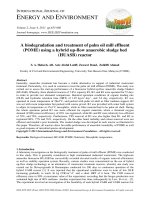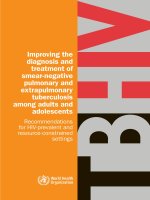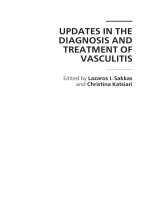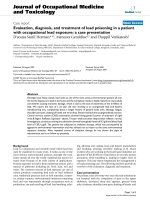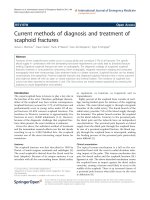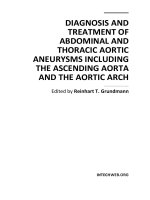Diagnosis and treatment of demodecosis with secondary bacterial infection in a pug - A case presentation
Bạn đang xem bản rút gọn của tài liệu. Xem và tải ngay bản đầy đủ của tài liệu tại đây (331.37 KB, 6 trang )
Int.J.Curr.Microbiol.App.Sci (2020) 9(5): 1753-1758
International Journal of Current Microbiology and Applied Sciences
ISSN: 2319-7706 Volume 9 Number 5 (2020)
Journal homepage:
Case Study
/>
Diagnosis and Treatment of Demodecosis with Secondary Bacterial
Infection in a Pug-A Case Presentation
G. Ambica1*, G. Abhinav Kumar Reddy2, Vinay M. Ratnalikar3, Sandepogu Ranjith
Kumar4, Keshamoni Ramesh5 and Maramulla Aruna6
Department of Veterinary Medicine, College of Veterinary Science,
Rajendranagar, Hyderabad-500030, Telangana state, India
*Corresponding author
ABSTRACT
Keywords
Pug, Demodicosis,
Pyoderma,
Alopecia,
Treatment.
Article Info
Accepted:
15 April 2020
Available Online:
10 May 2020
Skin infections are most common in dogs, especially pugs are more prone due to its folded
skin nature. A Pug of 3 years age weighing around 10 kgwas brought to the Veterinary
Clinical Complex, Rajendranagar, Hyderabad with the complaint of alopecia, pruritus,
decrease in the appetite and erythematous lesions all over the body. Detailed clinical
examination revealed mild increase in temperature (102.5 0F) and normal heart rate, pulse
and respirations. Skin scrapings and bacterial cultural examination revealed mixed
infection of Demodicosis and Staphylococcal pyoderma. Hence, both antiparasitic and
antibacterial medication was started in a proper way along with anti-inflammatory and
anti-allergic agents and also supportive therapy with Omega 3, Omega 6 fatty acid
supplements, immune boosters and hypoallergenic diet. Animal showed improvement
from next day of the therapy and treatment was continued with some modifications for two
months. Dog recovered completely and was confirmed by the negative findings in both
skin scrapings and bacteriological culture examination complete alleviation of skin lesions.
Introduction
Canine demodicosis is a refractory
dermatopathic consequence in the dog as
results of the pathological proliferation of
Demodex mites predominantly present in the
hair follicles. Canine demodicosis (Follicular
Mange) is an inflammatory skin disorder in
dogs associated with higher than normal
populations of Demodectic mites (Mueller,
2014). The Demodex mite is skin commensal
transmitted from bitch to puppies in the first
few days after birth (Gortel, 2006). It has a
very harmful effect on the health, utility and
cosmetic values in dogs (Chatterjee, 2007).
Clinical disease is influenced by numerous
such as genetic defect, alteration of skin's
structure, immunological disorders, hormonal
status, breed, age, nutritional status, oxidative
stress, endoparasites and debilitating diseases
but the immune status is thought to be the
most significant factor among all (Shanker
1753
Int.J.Curr.Microbiol.App.Sci (2020) 9(5): 1753-1758
Singh
&
Umesh
Dimri,
2014).
Immunosuppression allows the mites to
proliferate excessively in hair follicles,
resulting in clinical signs (Greve & Gaafar,
1966). The major clinical signs include mild
erythema, itching, partial or complete
alopecia, comedones and Pruritis (Ralf, et al.,
2011-12). The disease is mostly caused by
mite Demodex canis, however others mites
species like Demodex injai and Demodex
cornei may also cause the disease (Tater &
Patterson, 2008).
The disease occurs in nature in two forms:
localized and generalized (Scott, et al., 2001).
A generalized form is usually associated with
secondary bacterial infection and requires
vigorous and prolonged treatment (Mueller,
2012). Diagnosis is rapidly and reliably
confirmed by finding more than one mites per
microscopic field in deep skin scraping
(Soulsby, 1968). Treatment in such cases
should target both mite and bacteria.
Appropriate oral antibiotic therapy and
contemporaneous
topical
antimicrobial
therapy (whole-body soaks or shampoos) is
indicated in generalized demodicosis with
secondary bacterial infection along with
topical application of Benzoyl peroxide and
chlorhexidine-based shampoos (Kwochka
KW & Kowalski, 1991). Topical therapy with
shampoo removes crusts and debris that may
contain mites, exudate and inflammatory
mediators thus reduces the recovery time.
Materials and Methods
A three years Pug weighing around 10kg was
brought to the Veterinary Clinical Complex,
Rajendranagar with the complaint of alopecia,
pruritus, decrease in the appetite and
erythematous lesions all over the body for
one month. Clinical examination revealed
mild increase in temperature (102.5°F),
normal heart rate, pulse and respirations.
Detailed examination of skin revealed
erythema, pyoderma, alopecia and erosions
and lesions on face, around the eyes and ears,
chin region, fore limbs, hind limbs neck and
lateral and ventral abdomen [Fig.1,2 and3].
Skin scrapings were collected with scalpel
blade and collection of scrapings was
continued until there was slight ooze of blood
from dermal capillaries. Skin scrapings were
taken in 10% KOH and were heated gently till
hair gets digested and then centrifuged @
3000 rpm for five minute. The sediment was
examined under low and high power (10X
and 40X) of microscope. Skin surface
impressions collected were using sterile swab
for cultural examination.
Results and Discussion
Microscopic examination of the skin
scrapping was found positive for the skin mite
Demodex canis (Fig 4). Cultural examination
of skin surface impressions on MSA revealed
presence of clusters of Gram positive cocci
and were confirmed by Grams staining [Fig.5
and 6].
A multimodal approach was undertaken for
the therapy with both antiparasitic and
antibacterial medication in a proper way
along with anti-inflammatory and anti-allergic
agents and also supportive therapy. Dog was
treated with oral Tab. Neomec (Ivermectin)
10mg @ 600 μg/kg initially for 10 days and
later dose was decreased to @ 400μg/kg B.wt.
and was continued for one and half month.
Tab. Cephalixen@ 20mg/kg B.wt. BID was
given to control pyoderma resulted due to
secondary bacterial infection. Advised bath
with Sulbenz pet shampoo once in a week
which contains Bezoyl Peroxide - 2.5%
w/vused to remove crust and debris from the
skin; keratolytic agents, Micronized Sulphur 2% w/v and Salicylic Acid - 1% w/v which
causes the skin to shed dead cells from its top
layer by increasing the amount of moisture in
1754
Int.J.Curr.Microbiol.App.Sci (2020) 9(5): 1753-1758
the skin and dissolving the substance that
makes the cells clump together. This effect
makes it easier to shed the skin cells, softens
the top layer of skin, and decreases scaling
and dryness and Zinc oxide acting as soothing
agents. Prescribed Vet-pro Hypoallergenic
diet BID which contains optimum levels of
omega 3 and 6 fatty acids for healthy skin and
coat along with the added organic zinc and
selenium, aloevera extract and bromelain for
natural skin defense and to promote healing.
Topical application of Charmil ointment
containing Allium sativum, Azadiractaindica,
twice day and it has got an antibacterial
andanti-inflammatory action against inflamed
skin along with antipruritic action for
alleviating itching and irritation.Pup also
given Nutricoat syrup twice daily, containing
essential fatty acids, Linoleic (Omega 6) and
Linolenic (Omega 3) acids to minimize
oxidative stress along with the other vital
nutrients like biotin, Zinc, selenium, vitamins
A, D3 and E to supplement the action of
essential fatty acids in maintaining the skin
and coat condition.
Other supportive therapy with Immune
booster liquid, Immunol given @ 3ml p/o
thrice daily and antihistaminic tablet,
Levocetrizine @ 10 mg once daily for
alleviating intense pruritus. Dog started
showing the response from next day of the
therapy and treatment was continued for a
period of 2 months. Dog recovered
completely and was confirmed by the
negative findings in both skin scrapings and
bacteriological culture examination complete
alleviation of skin lesions (Fig.8 and 9).
Demodicosis, also known as red mange, is an
infestation of the dog by a variety of demodex
mite. Demodex mites are considered normal
residents of canine skin and have long been
recognized as the most common species in
dogs. Cutaneous changes in young and older
patients
include comedones,
papules,
pustules, follicular casts, plaques, crusts,
edema, and deep folliculitis and furunculosis
(Mueller, 2004). It resides in the hair follicles
and sebaceous glands and survives on
epidermal debris, cells and sebum (Miller WH
et al., 1993).
An impaired immune system causes the
proliferation of the mite leading to infestation.
A multiplying mite secretes a humoral factor
which suppresses the immune response
against the parasite, thus allowing its
proliferation (Ginel P. Demodicosebeim
Hund, 1996). In the current case, the clinical
manifestations like alopecia with follicular
pustules, moist and hemorrhagic exudation
were observed on the entire face and
forelimbs around ears and eyes and in the
interdigital space, pustules with draining tract
were in agreement with the earlier authors
(Sarkar P et al., 2004, Ballari S et al., )16,
15
.Most cases involve a secondary bacterial
skin infection, which needs administration of
systemic antibiotics for several weeks
concomitantly with the acaricidal treatment
(Verde Maite, 2005).
When demodicosis is complicated by
bacterial infection, therapeutic regime
requires a strategic approach that overcomes
the effects of both mite and bacteria to the
animal. Proper timing, frequency and duration
of treatment will determine the outcome of
therapy (Yatoo, et al., 2014). The essential
fatty acids are useful for maintaining the
health of the coat and help the pet to fight
against allergies and various skin problems.
Demodicosis is associated with oxidative
stress that predisposes dog for rapid
proliferation of mites; hence in current case
supportive therapy with essential fatty acids
was given.
Further, Ivermectin given for the current case
is with macrocyclic lactone which kills the
1755
Int.J.Curr.Microbiol.App.Sci (2020) 9(5): 1753-1758
parasite by potentiating gamma-aminobutyric
acid (GABA)–gated chloride channels
resulting in increased permeability (Fondati,
1996). Ivermectin is usually dosed at 300 to
600 lg/kg/d orally for treatment of generalized
canine demodicosis (Ristic, et al., 1995). The
shampoo Sulbenzpet, recommended for the
present case containing Benzoyl Peroxide is a
good keratolytic agent and has strong
follicular flushing action which assists in
clearance of mites from skin of dogs (Satish
Kumar et al., 2017).
Fig.1,2&3 Erythema and alopecia on face, around the eyes and ears; Chin region, fore limbs,
neck and ventral abdomen; Hind limbs and lateral abdominal areas
Figure.4 Demodex canis in skin scrapings under microscope
Figure.5 Staphylococcus showing
golden pigmentation on MSA
Figure.6 Microscopic view of staphylococcus
by Grams staining
1756
Int.J.Curr.Microbiol.App.Sci (2020) 9(5): 1753-1758
Figure.7 After one and half month of therapy
Figure.8&9 Recovered dog after two months of therapy
With the present case, it can be concluded
that the cases of demodicosis if not treated
in time can become complicated with
secondary bacteria leading to pyoderma and
such cases can effectively managed with
administration of ivermectin, and antibiotics
along with supportive therapy with
antihistamines, anti-inflammatory drugs,
hypoallergenic prescription diet and bathing
with benzoyl peroxide containing shampoo.
and other staff for providing the facilities
and assisting successful completion of this
case study.
References
Ballari S, Balachandran C, George VT, Manohar
BM. Pathology of canine demodicosis.
Chatterjee S. Studies on the incidences and
treatment of demodectic mange infection
in dogs with special reference to its herbal
therapy. M.V.Sc. Thesis submitted to
W.B.U.A.F.S., Kolkata, West Bengal,
2007.
Fondati A. Efficacy of daily oral ivermectin in
the treatment of 10 cases of generalized
demodicosis in adult dogs. Veterinary
Dermatology. 1996; 7:99-104.
Acknowledgement
The author wish to express sincere thanks to
Dr K. Satish Kumar, Professor &University
Head, Department of Veterinary Medicine,
College of Veterinary Science, PVNR TVU
1757
Int.J.Curr.Microbiol.App.Sci (2020) 9(5): 1753-1758
Ginel P. Demodicosebeim Hund. [Demodicosis
in dogs] [in German]. Waltham Focus.
1996; 6: 2-7.
Gortel K. Update on canine demodicosis.
Veterinary Clinics: Small Animal
Practice. 2006; 36(1):229-41.
Greve JH, Gaafar SM. Natural transmission of
Demodex canis in dogs. Journal of
American
Veterinary
Medical
Association. 1966; 148:1043-1045.
Kwochka KW, Kowalski JJ. Prophylactic
efficacy of four antibacterial shampoos
against Staphylococcus intermedius in
dogs. American Journal of Veterinary
Research. 1991; 52:115-118.
Miller WH, Jr, Scott DW, Wellington JR, Panic
R. Clinical efficacy of milbemycin oxime
in the treatment of generalized
demodicosis in adult dogs. Journal of the
American veterinary medical association.
1993; 203:1426- 1429.
Mueller RS, Vet Dermatol. Edn. 2014; 15(2):7589.
Mueller RS. Applied dermatology: an update on
the therapy of canine demodicosis.
Compendium, 2012, 34(4).
Mueller
RS. Treatment
protocols for
demodicosis: An evidence-based review.
Vet Dermatol 2004; 15:75-89.
Ralf S, Mueller EB, Lluís F, Birgit H, Stephen
L, Manon P et al., Shipstone. Treatment
of demodicosis in dogs: clinical practice
guidelines. Veterinary Dermatology.
2011-2012; 23(2):86.
Ristic Z, Medleau L, Paradis M, white-Weithers
NE. Ivermectin for the treatment of
generalized demodicosis in dogs. Journal
of the American Animal Hospital
Association. 1995; 207:1308-10.
Sarkar P, Mukherjee J, Ghosh A, Bhattacharjee
M, Mahato S, Chakraborty A, Mondal M,
Banerjee C, Chaudhuri S. A comparative
analysis of immuno restoration and
recovery
with
conventional
and
immunotherapeutic protocols in canine
generalized demodicosis: a newer insight
of immunotherapeutic efficacy of T11TS.
Immunological investigations. 2004;
33(4):453-68
Satish Kumar, Mrigakshi Yadav, Vidhi Kunwar,
Penny Arya, Radhika Prakash Bhatt,
Upadhyaya AK. Therepeutic managmemt
of mycotic demodecosis in a dog-a case
report. Indian Journal of Canine Practice.
2017; 9(2):117-118.
Scott DW, Miller WM, Griffin CE. Parasitic
skin diseases. In: Muller, K. (ed) Small
animal dermatology, 6th ed. W.B.
Saunders, Philadelphia, 2001, 423-516.
Shanker K Singh, Umesh Dimri. The
immunopathological
conversions
of
canine
demodicosis.
Veterinary
Parasitology. 2014; 203(1-2):1-5.
Soulsby EJL. Helminths, arthropods and
protozoa of domesticated animals (of
MSnnig's Veterinary helminthology and
entomology). Helminths, arthropods and
protozoa of domesticated animals (sixth
edition
of
MSnnig's
Veterinary
helminthology and entomology), 1968.
Tater KC, Patterson AC. Canine and feline
demodicosis. Vet. Med, 2008, 444-461.
Verde Maite, Canine Demodicosis. Treatment
Protocol. The North American Veterinary
Conference - Proceedings. 2005; 287:3.
Yatoo MI, Jhambh R, Malepad DP, Kumar P,
Dimri U. Advances in therapeutic
management of complicated demodicosis
in canines. J Adv. Parasitology. 2014;
1(1):6-8./
How to cite this article:
Ambica. G., G. Abhinav Kumar Reddy, Vinay M. Ratnalikar, Sandepogu Ranjith Kumar,
Keshamoni Ramesh and Maramulla Aruna. 2020. Diagnosis and Treatment of Demodecosis
with Secondary Bacterial Infection in a Pug-A Case Presentation. Int.J.Curr.Microbiol.App.Sci.
9(05): 1753-1758. doi: />
1758
